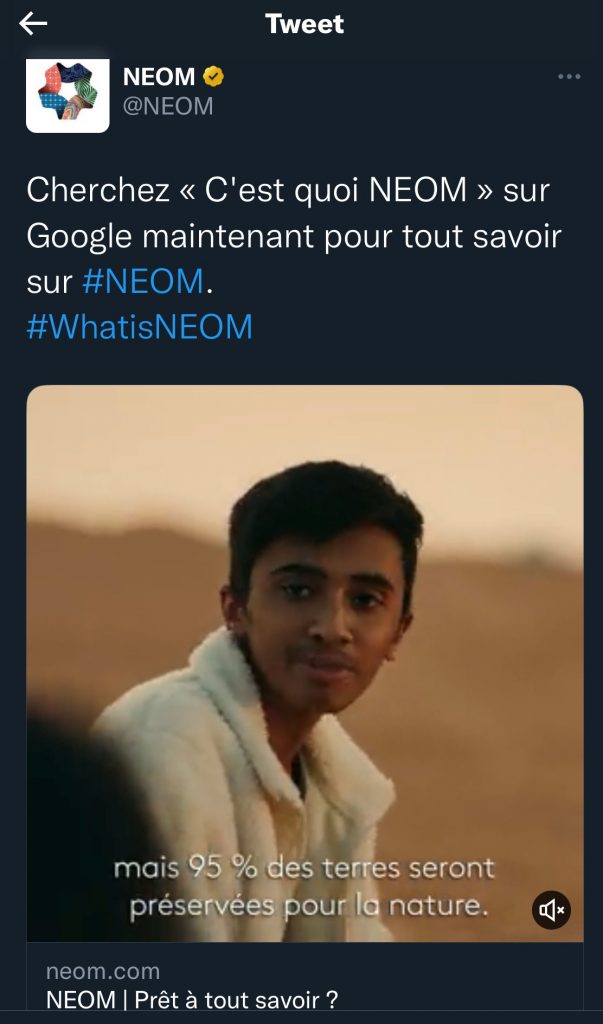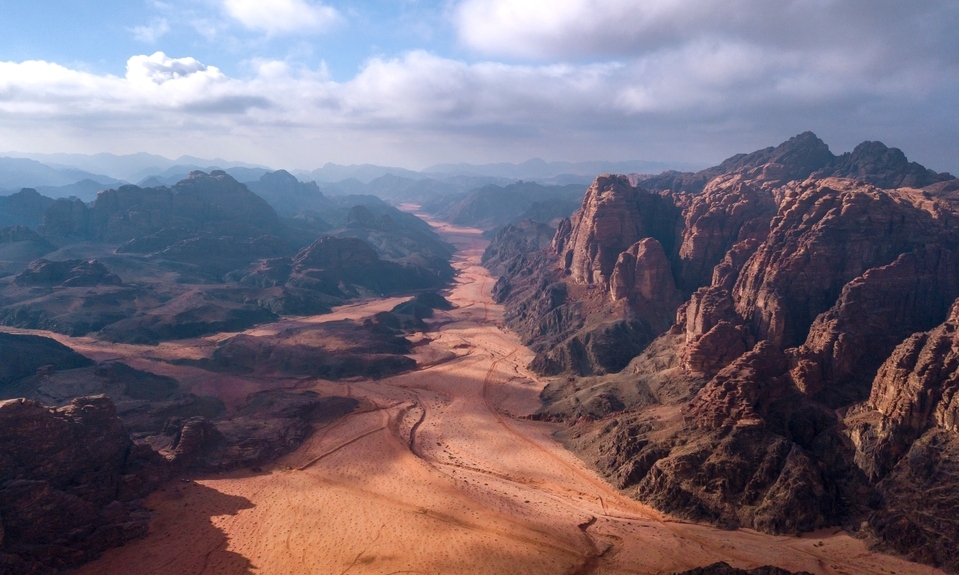While others are multiplying the loaves, Saudi Arabia is growing oases in the middle of the desert. That is what it is claiming, at least, amid much publicity. The Middle East’s largest oil-exporting country is to build NEOM, an immense green city that is bigger than Belgium. However, this ambition, which matches the imagination of Crown Prince Mohammed Ben Salman, is raising more questions than sand at the moment: is it a simple mirage or a move towards a greener future?
“What is NEOM?” If you use Twitter, you are likely to have come across this question, or rather this injunction. A tweet sponsored by the project itself asks you to search on Google. We are not asking you to share or click on a link here, but just to find out more: and the goal is clear – renown. Perhaps this is already a way of answering the question.

The NEOM project is an oasis in the heart of the desert. The targeted timeframe is 2030. It concerns a futuristic city, constructed in the middle of nowhere, which operates solely on renewable energy, futuristic robots and an independent administration, led by its shareholders. It is a science-fiction project, one that the Crown Prince of Saud Arabia, Mohammed Ben Salman (MBS), apparently takes very seriously. In 2021, he unveiled this enormous project as a key element of the Saudi Vision 2030 plan. The desert we are talking about is “bigger than Belgium” and is in Saudi Arabia.
Saudi Arabia is the world’s second-largest oil producer and almost 70% of its revenue depends on this oil; the country must indeed urgently consider the post-oil era for the future of its economy and its development. “There is much potential here,” said the journalist James M. Dorsey talking about the NEOM project. “It remains to be seen if it is realistic.” This Saudi ambition raises many questions, as ecological and energy-related as they are political. One thing is certain: this scheme is very useful for the image of MBS, who wishes to come across as the country’s moderniser.
NEOM, an empty field
The Middle East concentrates more than 50% of global oil reserves, which has made the region’s countries almost entirely dependent on this revenue. In Saudi Arabia, leaders are just starting to consider the energy transition, to diversify the economy in the face of the climate emergency. So, in 2016, Mohammed ben Salman unveiled the Saudi Vision 2030 plan, aiming to improve energy efficiency, diversify the mix (particularly thanks to renewable energy) and build tomorrow’s ecological and connected cities. To reach his goals, MBS intends to make Saudi Arabia the leading producer of blue and green hydrogen by building the world’s largest dedicated power station there; he also plans to construct 3 of the first 100 smart cities and to fight desertification by planting 100,000 trees. A key ambition for NEOM is to diversify the Saudi economy in the tourism, property and finance sectors, so as to prepare the post-oil era. It also aims to increase the country’s average life expectancy by six years.
Read also: In Saudi Arabia, everything must change for everything to remain the same
The plan is ambitious, yet the goals are far from being achieved: the hydrogen market scarcely exists today and it is proving difficult to find the investments that should enable the national hydrocarbon company, Aramco, to start exports in 2030. To date, the only actions taken in the desert have consisted in sentencing to death the inhabitants who refuse to leave it to allow NEOM’s construction… Among the three grandiose plans for smart cities, none has been completed yet. The Kingdom of Saudi Arabia is now stuck between planning and acting. And it must be tempted to slow down its post-oil transition for as long as possible.
A gigantic communication operation
Although NEOM is relying on technologies that do not yet exist, it would enable MBS to position himself as a model of transition, and as a leader in the field in the black gold region. Costed at 500 billion dollars, this city, which would be self-sufficient in terms of food and water, would also be independent as it would be solely governed by its shareholders. For these gigantic costs, there is a gigantic surface area: 26,500 square kilometres, in the middle of the desert, will be devoted to the futuristic megalopolis. The goal is also to address the demographic challenge and increase the immense Saudi territory’s population from 34 million inhabitants to over 60 million by attracting tourists and foreigners.
Given these stupendous figures and these plans worthy of Spielberg, how can we not wonder about NEOM’s real purpose: ultimately, is it not the world’s largest greenwashing project? The energetic and ecological contradictions of its founding principles are striking. All of this shows Saudi Arabia’s real inability to shift away from oil revenue and it is confirmed by figures: MBS had announced that 50% of national electricity would be produced by renewable energy by 2030. With seven years to go, only 0.1% of electricity has been attained. How then can we imagine that a zero-carbon city like NEOM could be built? Not to mention that the construction of The Line – a smart and futuristic city within NEOM – would generate around 1.8 gigatons of CO2! The project’s sustainability raises questions. Its construction alone would have enormous environmental consequences. While smart cities promise zero carbon thanks to new technologies, The Line is a perfect example of how these do not lead to overall decarbonisation, because their construction, operation and supply are so costly. And especially since NEOM would be built 500 metres high and the tallest buildings are the ones that consume the most energy.
The other NEOM
These many contradictions question the viability of the projects and the country’s capacity to take effective action for its transition. Similar projects have been conceived in the Middle East following the same rationale of diversification and transition. One of these is Masdar City, in the United Arab Emirates (UAE). This zero-carbon, zero-waste, smart city has been under construction since 2008. Masdar is a good reference point for NEOM. Its initial ambitions had to be downgraded, after the leaders were confronted with the physical, economic, social and political reality of their impracticable aims. The new focus is on rational targets, by building a low-carbon city, thanks in particular to a 40%-reduction in buildings emissions and to the use of electric public transport.
These projects are not more realistic from an economic point of view. Oil revenue represents 70% of the State budget. Initiating the transition to renewable energy would therefore greatly reduce project-funding capacities. This was proven in 2013, when the decrease in crude oil prices caused a significant budgetary deficit, weakening the Kingdom’s budget and public spending, and leading to public dissatisfaction. And this does not take into account that investors are difficult to convince: they, too, have questions about the real viability of these projects.
Dubai has a different strategy and has consequently become an illustrative example of how to shift away from oil revenue. Today, oil revenues only represent 6% of the city-state’s GDP, compared with 80% in the 1980s! This diversification has been made possible by the city’s longstanding trading tradition and by its appealing campaigns to attract investors (especially international ones) and fund more tangible and simple projects, such as the Dubai Mall or the Burj Khalifa, both of which have brought in great numbers of tourists. In 2022, Dubai was the fourth global tourist destination, with over 14 million visitors.
The diversion NEOM
In contrast, the attitude of the Saudi government raises questions. Is the goal to undertake the transition by diversifying the economy or is it to initiate increasingly grandiose projects, which, with their backdrop of green communication, are in reality simply furthering MBS’s ambitions for modernity – or for the appearance of modernity? NEOM has been designated as host of the 2029 Asian Winter Games. This project will require, in particular, the construction of a ski slope… in the heart of the desert! This contradiction was highlighted by the Saudi skier Fayik Abdile, who announced that he had “never thought he would ski in his own country one day.” Saudi Arabia will have to welcome, accommodate and feed the tourists attending the event. It is an event we know will inevitably generate pollution and consumption. The recent example of Qatar speaks volumes: flights were organised every ten minutes to welcome the tourists attending the football World Cup.
Read also: Gone with the sand: what will we remember of brand Qatar?
Behind the screen of the energy transition, it is really the kingdom of images and advertising that seems to be overseeing all these projects. The communication campaigns rolled out on a large scale, particularly on social media, mixing urban neoliberalism and political authoritarianism, are pushed to the limits to attract investors. At the same time, local people are made to disappear in Saudi Arabia. The inhabitants of the Tabouk province who refused to leave their homes to allow the smart city’s construction have, at best, been imprisoned.
There is a very clear difference between the promise of an independent, modern and liberal city like NEOM and the policy that has been put in place. All of this communication about the energy transition also enables MBS to keep his internationally contested actions quiet: enmeshment in the Yemen war, the diplomatic crisis with Qatar, rivalry with Iran, or even the possible involvement in the assassination of the journalist Jamal Khashoggi. The Crown Prince is satisfying his ambitions for modernity and establishing his authority in the region. We are far from the power and the independent government promised by NEOM, since Saudi political power is centralised, authoritarian and bureaucratic.
Transition, in the name of what?
Moreover, how should these projects be seen from a regional point of view? Should the NEOM project materialise, its autonomous and international government could change the political relationships and interests of the Middle East. Israel’s large investment in the Saudi project raises, in particular, the question of a possible recognition of the Hebrew state by Saudi Arabia, which has a Sunni majority.
Saudi Arabia’s veil of green communication, of which MBS has made himself the leader, is concealing an urgency to slow down the energy transition. All these paradoxes now bring the challenge of a real schism in reality, in which political discourse and realism co-exist without ever meeting each other. The Saudi economic structure seems far too rooted in oil revenue for it to be able to diversify, especially since the country, fundamentally a desert, where the local population does not work much, and which has almost no tourist infrastructure, does not have any other comparative advantage with which to diversify.






